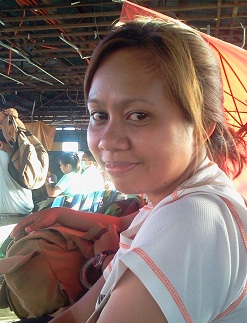By JOHNNA VILLAVIRAY GIOLAGON

On Nov. 8, Ivy waited in Cebu for word from her father and mother Elsa who both decided to stay in their home in Barangay Baras in Palo, Leyte as super typhoon Yolanda (international name Haiyan) hammered the central Philippines. Her worry turned to horror as a local news story flashed footage of her father’s car. Six out of seven passengers inside died as sea water surged inland, smashing everything against each other.
“The night before (Haiyan), I saw an advisory on Twitter I think that 15-foot waves would hit Ormoc. But there was no warning for Palo,” Ivy recalled as she waited for her flight from Tacloban back to Cebu.
Exactly a week has passed since Haiyan smashed into the Eastern Visayas, flattening the region and possibly taking as many as 10,000 lives as she made her way to mainland Asia.
Ivy’s parents survived the worst of Haiyan’s wrath by clinging on to beams that supported the second floor. Elsa had gotten swept outside by the current; luckily neighbors – who sought refuge in their home earlier – caught Elsa in time and managed to pull her back inside.
The couple are now with relatives in Ormoc, the city they left in the mid-1990s for Baras, Palo. Ivy’s 87-year old grandfather wasn’t as lucky though. He survived the deluge, submerged for hours in the cold seawater until the flood died down.
“They were resting that time, after the flood. He was sitting down and resting. And then suddenly he was no longer alive,” Ivy recalled her father telling her. “We think it could be hypothermia.”
What she couldn’t understand, though, was why her parents hadn’t gone to safer ground considering their experience in Ormoc.
“I asked him, and his explanation was that he wasn’t told they needed to evacuate. He said if they’d been told, of course they would’ve evacuated,” Ivy said.
She added that the people didn’t understand that a storm surge meant that the sea will swallow up everything.
“They thought a 15-meter storm surge meant waves, not the sea rushing inland. The information shared with the people wasn’t enough,” Ivy lamented.
The Onidas live a good 20 minutes walk from the coastal area. The people near the shore were told to evacuate, although some of them opted to ignore the warning.
“Those must be the ones that washed up near the houses. Our neighbors said they didn’t know who those people are,” Ivy said.
Ivy is not the first to raise attention over the inadequate warning given to the people about the dangers that Yolanda posed. She also shared widespread sentiment over the national goverrnment’s inadequate response to the disaster.
By the time Ivy left Baras to return to Cebu on Nov. 15, her village has yet to receive any relief assistance. Her consolation is that her parents are in Ormoc and that her father can receive regular medical attention.
The uncertainties and the difficult life in Leyte province has driven thousands of people out of the historical and once picturesque city. Tacloban Mayor Alfred Romualdez said as many as 30-40 percent of the city’s original 250,000-strong population have left the city.
Among these evacuees are the city’s biggest businessmen, who chartered private planes to fly them out, and a number or Romualdez’s own staff and supporters.
Romualdez underscored, though, that this should not be misinterpreted as people jumping ship.
“They want to take their family and children out to where they can be safe and have a place to stay and food to eat. After that, then they will come back to focus on the work that needs to be done,” he said, confident that Tacloban will rise anew the same way the city did after World War II.
Among the many who left Tacloban to provide more confortable living conditions for his young children is 35-year old Clint Gamba. Clint lived with his wife Lycel and children – 5-year old Obrain and 2-year old Chloe – in Barangay San Jose, Tacloban City.
Clint cradled a coughing Obrain on his lap as they waited for the plane to take off. His family was able to secure seats in a humanitarian flight to Manila via TigerAir.
“For now we’re staying with my sister in Quezon City. We will return maybe when everything’s more settled back home,” Clint said. “It’s not feasible for us to stay. Obrain’s cough is getting really bad, and there are no medicines available there.”
Obrain and Chloe had been safe in their grandfather’s house in Barangay Naga Naga when the flood swallowed their home in San Jose. Obrain only developed a cough that progressed to asthma as they waited exposed to the elements overnight for their plane.
As people continue to leave Tacloban, Romualdez expressed confidence that the city will pick itself up anew. “World War II, we rose up again. We can do it again this time,” Romualdez said.
Close to 4,000 people were killed when Yolanda hammered the central Philippines. The death toll is likely to rise as relief workers clear tons of debris that still litter the streets of Tacloban and other areas.